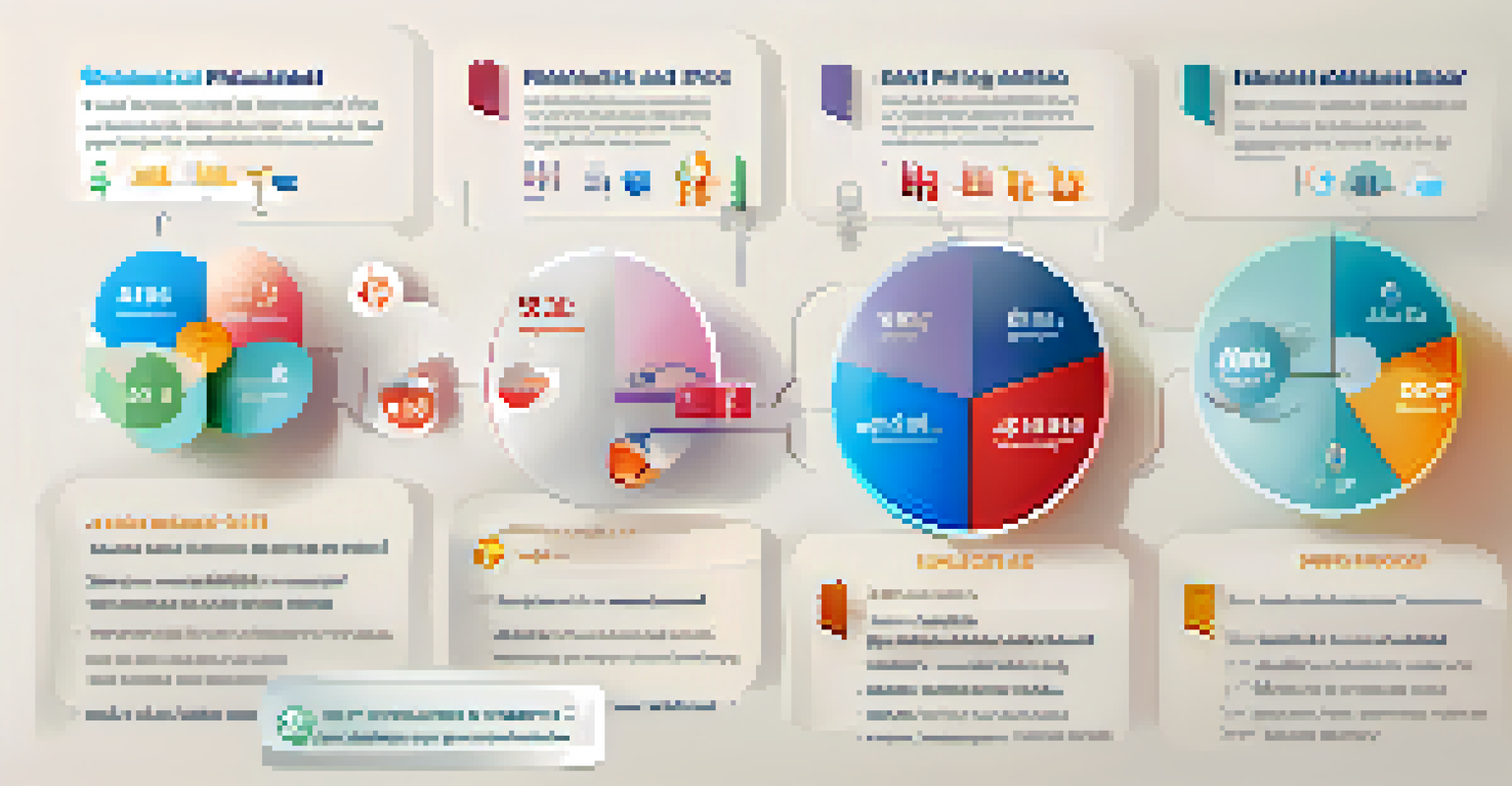Pharmaceutical Pricing Strategies and Economic Implications

Understanding Pharmaceutical Pricing Strategies
Pharmaceutical pricing strategies are essential for balancing innovation and accessibility. Companies often use various methods to set prices, including cost-plus pricing, value-based pricing, and competitor-based pricing. Each strategy reflects different priorities, such as recouping research and development costs or matching market standards. Understanding these strategies helps stakeholders grasp how prices are determined and the implications for consumers.
The price of a drug is not only determined by the cost of production but also by the perceived value it provides to patients and society.
Cost-plus pricing involves adding a markup to the production cost, ensuring that companies cover expenses while making a profit. On the other hand, value-based pricing sets prices based on the perceived value of a drug to patients and healthcare providers. This approach can lead to higher prices for innovative drugs that significantly improve health outcomes, creating a complex dynamic between cost and value.
Competitor-based pricing, meanwhile, takes into account the prices set by other companies for similar products. This strategy can foster competition but may also lead to price wars, which can harm smaller companies and ultimately reduce innovation. By understanding these fundamental pricing strategies, we can better analyze their wider economic implications.
The Role of Market Access in Pricing
Market access plays a critical role in pharmaceutical pricing, influencing how and when drugs reach patients. Companies often negotiate with insurance providers and pharmacy benefit managers to secure favorable coverage terms, which can directly affect pricing strategies. A drug that is easily accessible may see different pricing than one that faces significant barriers to market entry.

For example, some companies may choose to set lower prices for drugs that are essential for public health, ensuring they are covered by insurance plans. This approach not only promotes access but can also enhance a company's reputation and encourage brand loyalty. Conversely, high-priced specialty drugs may encounter pushback from payers, leading to complex negotiations that can delay patient access.
Pricing Strategies Shape Accessibility
Pharmaceutical companies use various pricing strategies, such as cost-plus, value-based, and competitor-based pricing, which significantly influence drug accessibility for patients.
Ultimately, effective market access strategies can help pharmaceutical companies optimize their pricing while ensuring that patients have timely access to necessary medications. By bridging the gap between pricing and accessibility, companies can foster a healthier marketplace that benefits all stakeholders.
Impact of Regulation on Pricing Strategies
Regulatory frameworks significantly influence pharmaceutical pricing strategies across different countries. For instance, some nations have strict price controls that limit how much companies can charge for their products, which can lead to lower prices for consumers. In contrast, countries like the United States allow companies more freedom to set prices, often resulting in higher costs for consumers and insurers.
Access to medicines is a global challenge and must be addressed through equitable pricing practices that prioritize patient needs.
These regulatory environments shape how companies approach pricing, pushing them to adapt their strategies to comply with local laws while maximizing profits. In regions with strict regulations, firms may invest more in lobbying efforts to influence pricing policies or seek to differentiate their products through innovative marketing. However, such strategies can come with risks, including public backlash and potential reputational damage.
Understanding the interplay between regulation and pricing is essential for stakeholders, as it can affect drug availability and affordability. The ongoing debate around pharmaceutical pricing often centers on how to balance the need for innovation with the necessity of keeping medications accessible to the public.
The Economic Implications of High Drug Prices
High drug prices present significant economic implications for both individuals and the healthcare system. When patients face exorbitant costs for medications, it can lead to difficult choices, such as skipping doses or forgoing treatments altogether. This not only impacts individual health outcomes but can also escalate overall healthcare costs due to complications arising from untreated conditions.
Moreover, high pharmaceutical prices can strain public health budgets, especially in countries where governments provide universal healthcare coverage. As governments allocate more resources to subsidize expensive medications, funding for other essential services may suffer. This creates a ripple effect, affecting everything from hospital funding to preventive care initiatives.
Market Access Affects Drug Pricing
Effective market access strategies, including negotiations with insurers, are crucial for determining how drugs are priced and ensuring patient access to necessary medications.
Addressing the challenge of high drug prices requires a multifaceted approach that includes policy reforms, market innovations, and collaboration between stakeholders. By focusing on sustainable pricing models, the industry can work towards a system that maintains innovation while ensuring that medications remain affordable for those in need.
Value-Based Pricing: A New Approach
Value-based pricing is emerging as a transformative approach in the pharmaceutical industry, focusing on the benefits a drug provides relative to its cost. This strategy seeks to align drug prices with the actual health outcomes achieved, making it a more patient-centered approach. By emphasizing the value a medication delivers, companies can justify higher prices for drugs that significantly improve quality of life.
For instance, a new cancer treatment that extends survival rates may be priced higher than traditional therapies due to its considerable benefits. Health technology assessments are often used to evaluate this value, providing a framework for determining appropriate pricing. Such assessments consider various factors, including clinical efficacy, patient quality of life, and overall economic impact.
However, transitioning to a value-based pricing model presents challenges, including establishing clear metrics for value and navigating complex stakeholder relationships. Successful implementation could lead to a more equitable system that rewards innovation while ensuring that patients receive effective treatments at reasonable prices.
Ethical Considerations in Pharmaceutical Pricing
Ethical considerations are increasingly coming to the forefront of discussions around pharmaceutical pricing strategies. The debate often centers on the fairness of pricing in light of the substantial investment required to develop new drugs. While companies argue that high prices are necessary to fund research and development, critics contend that these costs should not come at the expense of patient access.
Furthermore, the disparity between drug prices in different countries raises ethical questions about global health equity. Patients in lower-income regions may face prohibitively high costs for the same medications that are more affordable elsewhere, leading to calls for more equitable pricing practices. This disparity underscores the importance of addressing the ethical dimensions of pharmaceutical pricing.
Ethics in Drug Pricing Matter
The ethical implications of pharmaceutical pricing highlight the need for fairness and transparency, especially concerning access to medications in different regions.
As the industry navigates these complex ethical issues, transparency in pricing and decision-making becomes crucial. By fostering open dialogue and considering the broader societal implications of pricing strategies, pharmaceutical companies can work towards solutions that prioritize both innovation and public health.
The Future of Pharmaceutical Pricing Strategies
The future of pharmaceutical pricing strategies is likely to be shaped by ongoing trends in technology, regulation, and consumer expectations. With the rise of data analytics and real-world evidence, companies can better understand the value of their products and refine their pricing accordingly. This shift towards a more data-driven approach could lead to more transparent and justifiable pricing models.
Additionally, as patients become more informed and engaged in their healthcare decisions, they are increasingly demanding fair prices and better access to medications. This consumer pressure may drive changes in how drugs are priced and marketed, encouraging companies to adopt more patient-centered strategies. Companies that prioritize transparency and value will likely gain a competitive advantage in this evolving landscape.

Moreover, collaboration among stakeholders, including healthcare providers, payers, and policymakers, will be essential in shaping the future of pharmaceutical pricing. By working together to create sustainable pricing models, the industry can ensure that innovation continues while also meeting the needs of patients and society as a whole.